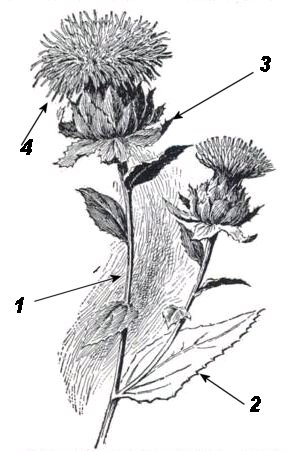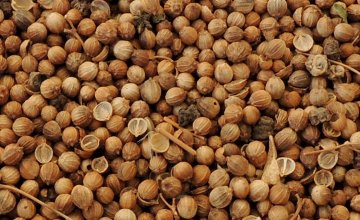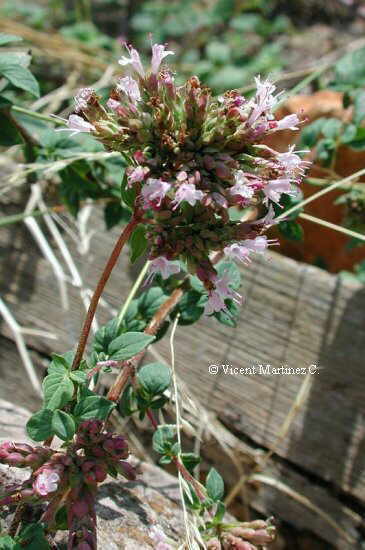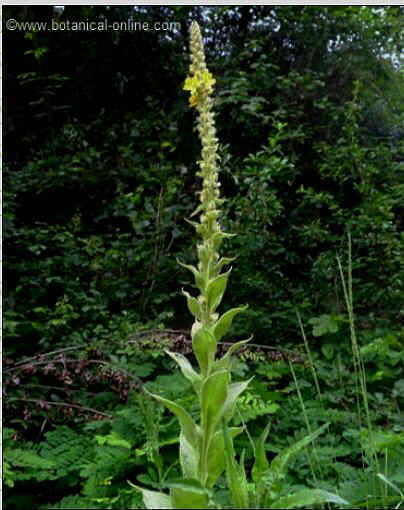Contents
- 1 What are healthy fats and their benefits?
- 1.1 BENEFITS OF HEALTHY FATS
- 1.2 What are good or healthy fats?
- 1.3 Can fats be bad?
- 1.4 Why are fats important to the body?
- 1.5 Types of fats: what are healthy or beneficial fats?
- 1.6 Unsaturated fats “omega”
- 1.7 Quality of foods rich in healthy fats
- 1.8 Properties of Monounsaturated Fats and Benefits: Omega 9
- 1.9 Foods rich in omega 9
- 1.10 Scheme on vegetable fats
- 1.11 Properties and benefits of polyunsaturated fats
- 1.12 Essential fatty acids omega 3 and omega 6
- 1.13 Foods rich in omega 3 and omega 6 (polyunsaturated)
- 1.14 Foods rich in beneficial fats
- 1.15 TABLE WITH THE CONTENT IN UNSATURATED FATS PER 100G
- 1.16 Why must be a balance between omega 3 and omega 6
- 1.17 What about saturated fats and cholesterol?
What are healthy fats and their benefits?
BENEFITS OF HEALTHY FATS
What are good or healthy fats?
Healthy or good fats are components that our diet must provide by means of healthy foods.
They are popularly known as “good” or “healthy” fats because it has been proven that their presence in food, through the ingestion of food containing them, brings health benefits.
Can fats be bad?
Virtually all fats are good for the body, because they are essential components for health.
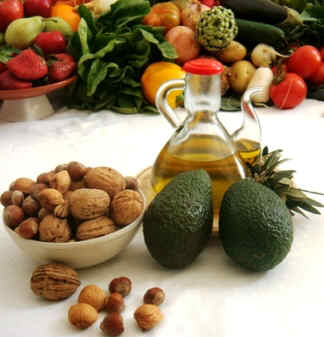
Photo of nuts, avocado and oil, vegetable foods rich in oil
Why are fats important to the body?
These are the main functions of fats in the body:
- Manufacture of hormones
- Produce digestive juices
- Structural function (they are part of all cells of the body whose membranes are lipids).
- Fats are also the main component of the nervous system (fats allow the nervous connection), allow good health of the heart,…
Without fat, good health would not be possible .
However, there are some fats that are bad or harmful when they are in excess in the diet.
Types of fats: what are healthy or beneficial fats?
There are different types of fats and some must be more present in the diet than others.
Good fats for health are those whose consumption helps prevent diseases and help the body to function properly. Foods rich in this type of fats should be found in more abundance in food.
Unsaturated fats “omega”
Healthy fats are the so-called unsaturated fats or omega fats. These types of fats are identified on food labels as unsaturated fats.
Within the group of unsaturated fats are monounsaturated fats (omega 9 or oleic acid) and polyunsaturated fats (which are omega 3 and omega 6).
Monounsaturated fats should be more present in the diet than polyunsaturated fats. That is, you have to consume more omega 9 than seed oils.
Quality of foods rich in healthy fats
Fats are just one component of food, whose presence does not determine whether it is healthy or not. The benefits of healthy fats should be framed within the context of a healthy diet and a food of good nutritional quality.
For example, if snacks or cookies contain olive oil, this does not mean that they are healthy, but it should be evaluated if each food is processed, high in salt, sugar, etc. Fried nuts with salt are not healthy, although they contain omega fats, because the high temperatures deteriorate the healthy fats.
In short, whenever you talk about the properties of fats, this should be framed within foods of quality (nuts without salt and without frying, unheated oils, etc.).
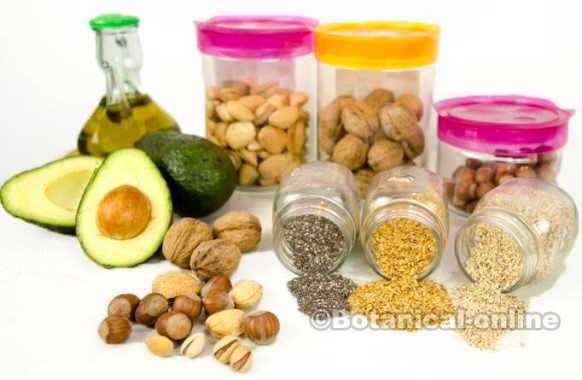
Photo of high quality vegetable foods rich in fats or healthy oils: virgin oils, avocado, nuts and oilseeds (almonds, walnuts, hazelnuts, chia, flax, sesame,…)
Properties of Monounsaturated Fats and Benefits: Omega 9
Between the two types of unsaturated fats, (monounsaturated and polyunsaturated) monounsaturated fats are those that can be consumed in greater quantity, because chemically they are more stable to the degradation and therefore, take longer to oxidize within the organism. That is, the cells formed with omega 9 will be resistant.
We should highlight their properties related to heart disease: it has shown that populations that follow diets rich in omega-9, such as the Mediterranean diet, have a lower incidence of coronary heart disease and certain types of cancer.
This type of fat also helps prevent degenerative diseases like Alzheimer’s.
* More information: Properties of omega 9
Foods rich in omega 9
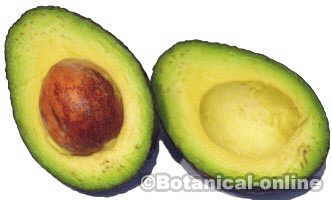
Photo of avocado (palta), a fruit very rich in omega 9
The most abundant monounsaturated fat in the diet is omega 9.
The foods rich in omega 9 are avocado, hazelnuts, olives and olive oil.
Fatty parts of meats, such as pork, also contain a lot of omega-9 (they contain more omega-9 than saturated fats) because monounsaturated fats are an excellent source of energy for animals and humans.
Sausages, although containing omega 9, are not recommended because of their salt content, flavor enhancers and carcinogenic additives such as nitrites.
* More information: Food rich in omega 9
Scheme on vegetable fats
The drawing clarifies the subject of unsaturated fats. The film shows the two types of fats considered – in general – as healthy, that is, those that should be found in greater quantity in the diet:
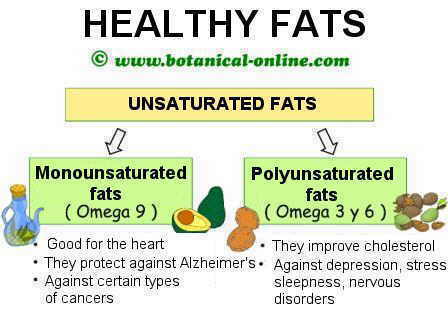
Summary image of vegetable oils or fats good for health. By © Botanical-online.com
Properties and benefits of polyunsaturated fats
Polyunsaturated fats are healthy, but it is preferred to be consumed in less quantity than monounsaturated fats in the diet, because they are less stable.
One of the characteristics of these fats is that they oxidize easily because chemically they are less stable than monounsaturated fats. This is because they contain more than one unsaturation (polyunsaturated).
Essential fatty acids omega 3 and omega 6
Polyunsaturated fats are what are popularly known as omega 3 and omega 6.
They have a very important role for health because they are essential fatty acids, that is, a type of fats that the body can not synthesize and therefore we have to obtain them through food.
The body needs these fats to make different substances. For example, lack of essential fatty acids has been shown to increase the symptoms of nerve disorders such as depression, insomnia and hyperactivity.
A satisfactory contribution of these fats helps to maintain a good memory, since they are part of neurotransmitters. They also improve the fatty profile of blood by increasing good cholesterol.
Foods rich in omega 3 and omega 6 (polyunsaturated)
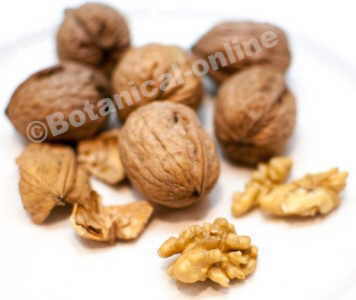
Photo of walnuts. Walnuts very rich in polyunsaturated fatty acids
Polyunsaturated fats abound in oilseeds or nuts, as well as in their oils:
- Flaxseed, walnuts, sunflower seeds,
- Pumpkin seeds, sesame seeds,
- Linseed oil, sunflower oil, etc.
* More information: Foods rich in essential fatty acids
Foods rich in beneficial fats
The table below shows the content of omega 9, omega 6 and omega 3 fatty acids in different foods. Most foods are rich in omega-6 and omega-9 fatty acids, while omega-3 sources are more limited.
Mainly the list contains vegetable oils and nuts, which are foods rich in healthy fats, good fats or unsaturated fatty acids:
TABLE WITH THE CONTENT IN UNSATURATED FATS PER 100G
| Food per 100g. | MONOUNSATURATED FATS | POLYUNSATURATED FATS | |
| Oleic acid Omega 9 (g.) | Linoleic acid Omega 6 (g.) | Linolenic Omega 3 (g.) | |
| Peanut oil | 44,8 | 32 | 0 |
| Sunflower oil | 20,2 | 63,20 | 0,10 |
| Cod liver oil | 18,3 | 2,60 | 0,10 |
| Corn oil | 29,4 | 50,40 | 0,90 |
| Olive oil | 70 | 9,1 | 0,85 |
| Soy oil | 20,8 | 51,50 | 7,30 |
| Almonds | 32,6 | 12,60 | 0,26 |
| Cashew nuts | 24,4 | 7,20 | 0,15 |
| Hazelnuts | 45,8 | 8,50 | 0,11 |
| Peanuts | 21,6 | 12,80 | 0,35 |
| Walnuts | 10,8 | 34 | 8 |
| Sunflower seeds | 10,7 | 37,40 | 0,08 |
| Pistachios | 34,8 | 7,9 | 0 |
Why must be a balance between omega 3 and omega 6
If too many polyunsaturated fats are taken, for example using seed oils (sesame oil, sunflower oil, linseed oil, etc.), many free radicals can be generated in the body due to the oxidation of these fats.
For this reason it is advisable to take mainly foods rich in monounsaturated oils, because these also contain certain amounts of omega 3 and 6, which are sufficient to meet the needs.
In addition, monounsaturated fats help balance dietary fats because they do not contain as much omega 6 as vegetable seed oils.
* See: Importance of the balance between omega 3 and omega 6
What about saturated fats and cholesterol?
In general terms, saturated fats and cholesterol, which are mostly found in foods of animal origin, should be consumed in lesser amounts because their excess produces negative effects (poor circulation, increased cholesterol, etc.)
* Related information:
![]() More information on fats.
More information on fats.


